
Confucian Ritual and Reduced Deviancy among Young People
© Institute of Confucian Philosophy and Culture, 2022
Abstract
This is a study of the connection between Confucian ritual and reduced deviancy among young people. Within Confucianism, rituals control behavior and reduce deviancy. Previous studies have linked family rituals with positive behavioral outcomes for young people across a range of developmental dimensions, prompting the current test applied to deviancy. Two main tests were conducted. In the first test, a ritual variable, “family routines,” was tested by negative outcome variables. This data was from the NLSY97, in the years 1997 to 2000, with a sample of 2,846 people. It was found that family routines were linked to reduced delinquency and substance use, even after controlling for gender, ethnicity, age, and so on. In the second test, a ritual variable, “how often the mother reads to the child,” was tested by negative outcome variables. This data was from the NLSY79CYA, in the years 1988 and 1998, with a sample of 1,087 mothers and children. It was found that ritualized mother-child reading was linked to reduced antisocial behavior and bullying, even after controlling for gender, ethnicity, and age.
Keywords:
Confucianism, ritual, deviancy, NLSY97, NLSY79CYAThis study explores the connection between Confucian ritual or li (禮) and reduced deviancy among young people. It examines the question of whether ritualistic behaviors can reduce deviancy. If there is a connection between ritual and reduced negative behavioral outcomes, the inclusion of ritual into social and correctional programs may increase public safety.
The views of Confucius (551-479 BCE) and Xunzi (c.300-c.230 BCE) are considered.1 Their ideas are pertinent to criminological issues as they were regular advisors to feudal administrators regarding the control and punishment of populations. As such, explanations for misconduct are thoroughly articulated within their philosophical material.
Studies suggest that ritual increases behavior regulation and benefits mental health. Kiser, Bennett, Heston, and Paavola (2005) examined the relationship between family rituals and the psychological health of children and found that “family rituals are a correlate of child well-being,” and that “the constructive use of family rituals is reliably linked to family health and to psychosocial adjustment” (357). Malaquias, Crespo, and Francisco (2015) analyzed the relationship between family ritual and the social connections, depression, and anxiety of 248 Portuguese students. From self-report questionnaires, they found that, “Family ritual meaning was positively related to social connectedness and negatively related to depression” (3009). Santos, Crespo, Silva, and Canavarro (2012) conducted a cross-sectional study of 149 Portuguese children, and found that, “Stronger family ritual meaning predicted a more positive family environment (i.e., higher cohesion levels and lower conflict levels), better health-related quality of life, and fewer emotional and behavioral problems in youths” (557). These results follow other studies that found significant positive relationships between family rituals and the healthy cognitive/emotional functioning of young people (Fiese, Koley, and Spagnola 2006), and family rituals and family cohesion (Fiese and Kline 1993).
Although juxtapositions between ritual and law, and the unique challenges and value each provides for society, have been discussed (Hutton 2021), there has been little thorough and direct analysis of Confucian ritual from a criminological standpoint, and little empirical testing therein. This subject is of significant value, given that childhood influences have a habit of altering behavior later in life (see Cline 2015; Farrington 2005).
I. Confucian Ritual
Within Confucianism, rituals are instrumental for generating self-control and morality. Bell (2008) describes Confucianism as an “action-based” ethical philosophy, wherein “One learns by participating in different rituals and fulfilling different responsibilities in different roles, and the wider the life experience, the greater the likelihood that one has developed the capacity for good moral judgement in this or that situation” (152). These ritualized actions are to hold meaning that exceeds any practical value. Ivanhoe (2013) explains, “Confucian li includes those regular, stylized social practices that express significance or meaning beyond their instrumental utility, those behaviors that possess symbolic value to those within a shared community” (32).
Confucian rituals are behavioral norms and forms of personal etiquette meant to draw children into a family system and control behavior. Norms draw children into the family, and ritualized etiquette regulates the mind. Correspondingly, Confucian ritual also forms people’s emotions, sensibilities, temperaments, and rationales. Wang (2012) illustrates the controlling effects of ritual, “In the process of exercising li, individuals keep a tight rein on their feelings, emotions, and desires as a means to restraining their behavior to meet the standards of communal life” (89). Xunzi (1999) asserted that rituals control and foster the desires of people—forming a middle-ground between overindulgence and yearning, writing, “The Ancient Kings abhorred . . . disorder; so they established the regulations contained within ritual and moral principles in order to apportion things, to nurture the desires of men, and to supply the means for their satisfaction” (19.1, 601).
Through ritualized bonding within the family, order is created, and, from this order, impulsivity and deviancy are reduced. For example, Confucian ritual often expounds on the limits of a son’s autonomy within the family. These ritualized guidelines are to increase parent-child attachment and self-control. The Liji (Book of Rites) states, “A filial son will not do things in the dark, nor attempt hazardous undertakings, fearing lest he disgrace his parents” (Qu Li I, 19).
Xunzi (2003) thought that people are inherently bad, and it is through ritual that this innate nature can be overcome; he explains, “Since man’s nature is evil, it must wait for the . . . guidance of ritual principles before it can become orderly. . . . If they have no ritual principles to guide them, they will be perverse and violent and lack order” (162). Rituals distance people from their counterproductive dispositions. They attach people to a behavioral framework in which desires can be achieved in a controlled manner.2 Rituals control desires and reduce deviancy.
A. Family Routines Are Often Confucian Ritual
Confucians rituals are often common routine behaviors—how to behave bodily and vocally in everyday social situations (e.g., table etiquette, how parents should interact with children and vice versa, and how music should be played within the family to create optimum harmony).3 Confucius explains this general idea in the Book of Rites, “The superior man is careful in small things, and thereby escapes calamity. . . . His courtesy [as a product of ritual] keeps shame at a distance,” and “The superior man, by his gravity and reverence [ritual], becomes every day stronger for good; while indifference and want of restraint lead to daily deterioration. The superior man does not allow any irregularity in his person, even for a single day” (Biao Ji, 5, 6). These common routines form and train comportment.
Family routines are often Confucian ritual. For example, the act of a family having dinner together on a regular basis is ritual, because it is regular and meaningful behavior that produces family bonding and the development of self-control through dining etiquette. A family regularly visiting the children’s grandparents or other relatives on the weekends are rituals that serve a similar purpose: family bonding, the transmission of moral lessons between generations, and displays of filial piety. The point is that Confucian ritual fits many different social circumstances. Ivanhoe (2000) explains, “Even under normal circumstances, the virtuous person is always fine-tuning the expression of virtue to fit the occasion and acting from the greater perspective of the overarching goals of ritual. No simple set of prescriptions will suffice to guide or describe such a person’s conduct” (2). What is important is that regular and meaningful patterns of prosocial behavior are conducted within the family. These routine activities pull family members together so that norms, expectations, and moral lessons can be conveyed. Xunzi (2003) points out the importance of regular family interactions within daily living:
If all matters pertaining to temperament, will, and understanding proceed according to ritual, they will be ordered and successful; if not they will be perverse and violent or slovenly and rude. If matters pertaining to food and drink, dress, domicile, and living habits proceed according to ritual, they will be harmonious and well regulated; if not they will end in missteps, excesses, and sickness. (26, emphasis added)
An illustration of family routines as Confucian ritual, and something that occurs regularly in modern times, is when children serve their parents in a day-to-day manner. This system of routine conduct was codified in the Book of Rites:
With bated breath and gentle voice, they [children] should ask if their clothes are too warm or too cold, whether they are ill or pained, or uncomfortable in any part; and if they be so, they should proceed reverently to stroke and scratch the place. They should . . . help and support their parents in quitting or entering the apartment. They will ask whether they want anything, and then respectfully bring it. All this they will do with an appearance of pleasure to make their parents feel at ease. (Nei Ze, 4)
In Confucian thought, these regular and meaningful interactions pull families together in harmony, thus diminishing criminality. Confucius explains how a failure to engage in ritual will result in misconduct and malevolence, “Respect shown without observing the rules of propriety [ritual] is called vulgarity . . . and boldness without observing them is called violence. Forwardness takes away from gentleness and benevolence” (Book of Rites, Zhongni Yan Ju, 1).
II. Current Analysis
Given the aforementioned theoretical backdrop, the main question of this study is: Is there a link between ritual and reduced deviancy among young people? To respond the prevailing research gaps, two tests were administered.
A. Current Analysis Test One (NLSY97)4
The first test investigated whether one NLSY97 ritual variable: (1) family routines, in the years 1997, 1998, 1999, and 2000, was linked to two NLSY97 behavioral outcome variables (1) delinquency (years 1997 and 2000) and (2) substance use (years 1997 and 2000). This test controlled for ethnicity, gender, year of birth, the age of the biological mother when she first gave birth, gross household income in the past year, the biological mother’s highest grade completed, and the biological father’s highest grade completed.
Confucian rituals often consist of regular, meaningful, and routine conduct. The “family routines” variable in the NLSY97 is Confucian ritual because family routines are often regular and meaningful conduct. The family routines in this variable are positive and prosocial, in the same way that Confucian ritual is positive and prosocial. The description of the “family routines” variable in the NLSY97 conveys this information, “Index of family routines. Based on . . . the number of days per week the youth’s family eats together, does housework, does something fun together, and does something religious together” (Bureau of Labor Statistics, 2019). For Confucius, these meaningful family routines qualify as ritual; Ivanhoe (2013) explains:
Kongzi thought the clothes we wear and how we maintain and wear them, our deportment and demeanor, how we sit upon our mats and whether our mats are properly arranged, what food we eat and how we cut and consume it—all these things fall within the ambit of ritual. Kongzi saw that all of these activities can be important . . . all can serve as means to cultivate ourselves in ways that contribute to a more humane social ideal. (33)
For example, in ritualized visits to aging family members, a normal family routine in contemporary times, the Book of Rites describes how young people should behave, “He did not presume to ask their age . . . when he met them on the road, if they saw him, he went up to them, but did not ask to know where they were going. . . . When seated by them, he did not, unless ordered to do so, produce his lutes. He did not draw lines on the ground, that would have been an improper use of his hand. He did not use a fan. . . .” (Shao Yi, 8). These rituals should be engaged habitually and decisively. Common modern family routines involve playing music or listening to music within the home. The Confucians believed that these musical activities are rituals of high importance, “When it is preformed within the household, and father and sons, elder and younger brothers listen to it together, there are none that are not filled with a spirit of harmonious kinship. . . Hence music brings about complete unity and induces harmony” (Xunzi 2003, 116). Modern gaming rituals within the family require a degree of etiquette and decorum; Confucian ritual is concerned with the same, “At the throwing of darts. . . . If he conquered, he washed the cup and gave it to the other, asking him to drink. If he were defeated, the elder went through the same process with him” (Book of Rites, Shao Yi, 9), and, when engaged in a game, “the young people were admonished in these words, ‘Do not be rude; do not be haughty; do not stand awry; do not talk about irrelevant matters. . . .’” (Book of Rites, Tou Hu, 6). Modern family dinners are often defined by meaningfulness, dining etiquette, and self-control at the dinner table; Confucian rituals emphasize the same, “When their parents give them anything to eat or drink, which they do not like, they will notwithstanding taste it and wait. . . .” (Book of Rites, Nei Ze, 16). Thus, family routines are often Confucian ritual.
B. Current Analysis Test Two (NLSY79CYA)5
The second test investigated whether two NLSY79CYA ritual variables: (1) how often the mother reads to the child (3-5 yrs), in the years 1988 and 1998, and (2) how often the mother reads to the child (6-9 yrs), in the years 1988 and 1998, were linked to two NLSY79CYA behavioral outcome variables (1) antisocial behavior (years 1988 and 1998) and (2) child bullies or is cruel/mean to others (years 1988 and 1998). This test controlled for gender, ethnicity, and year of birth.
The “how often the mother reads to the child (3-5 yrs and 6-9 yrs)” variables in the NLSY79CYA are Confucian ritual because, like the family routines variable in the NLSY97, routine mother-child reading is consistent and meaningful conduct. For instance, regarding ritualized learning in the home, a form of routine parent-child reading in the modern home, the Book of Rites states, “At six years old, they were taught the numbers and names of the cardinal points . . . at nine, they were taught how to number the days” (Nei Ze, 77), and “At ten (the child) went to a master outside . . . he learned the characters and calculation . . . he would be exercised in reading the tablets” (Nei Ze, 78). Routine learning in the home is Confucian ritual, “The child of a good founder is sure to learn how to make a fur-robe. The son of a good maker of bows is sure to learn how to make a sieve. [In other words] Those who first yoke a young horse place it behind, with the carriage going on in front of it” (Book of Rites, Xue Ji, 15), and “When the pupils withdrew, and gave up their lessons for (for the day), they were required to continue their study at home” (Book of Rites, Xue Ji, 6). This interconnection between modern family routines/reading and Confucian ritual proceeds throughout the principle Confucian texts. Ultimately, routine parent-child reading is Confucian ritual.
C. Hypotheses
Confucian ritual involves regular and meaningful conduct for purposes of behavior regulation. Therefore, the hypotheses are as follows:
The hypotheses of the first test (NLSY97):
Hypothesis 1: Family routine scores in the NLSY97 1997 cycle array from 0 to 28; higher scores specify more days expended in routine events with the family. Family routines in the 21 to 28 range (the top 25%) are most characteristic of Confucian ritual. Accordingly, scores in the 21 to 28 range will be linked to a reduced likelihood for delinquency and substance use.
Hypothesis 2: Family routine scores in the NLSY97 1998, 1999, and 2000 cycles array from 0 to 21; higher scores specify more days expended in routine events with the family. Family routines in the 16 to 21 range (the top 25%) are most characteristic of Confucian ritual. Accordingly, scores in the 16 to 21 range will be linked to a reduced likelihood for delinquency and substance use.
The hypotheses of the second test (NLSY79CYA):
Hypothesis 3: How often the mother reads to the child (3-5 yrs and 6-9 yrs) scores in the NLSY79CYA 1988 and 1998 cycles array from 1 to 6; higher scores indicate more mother-child reading. Reading in the 5 to 6 range (the top 33%) is most characteristic of Confucian ritual. Thus, scores in the 5 to 6 range will be linked to a lower likelihood for antisocial behavior and bullying or being cruel/mean to others.
III. Methodology
A. Methodology of the First Test (NLSY97)
The data used for this research came from two datasets: the NLSY97 and NLSY79CYA. The data for the first investigation came from the first four cycles of the NLSY97, collected from 1997 to 2000.
As recommended by Cramer and Bock (1966), two-way MANCOVAs were used to help defend against expanding the type 1 error rate in any subsequent ANCOVAs and post-hoc assessments.
Two two-way MANCOVAs were conducted in the first test:
MANCOVA 1: examines the influence of two independent variables: (1) family routines (1997) and (2) family routines (1998), on two dependent variables: (1) delinquency scores (1997) and (2) substance use (1997).
MANCOVA 2: examines the influence of two independent variables: (1) family routines (1999) and (2) family routines (2000), on two dependent variables: (1) delinquency scores (2000) and (2) substance use (2000).
Both MANCOVAs controlled for gender, ethnicity, year of birth, gross household income in the past year, the age of the biological mother when she had the first born, the biological mother’s highest grade completed, and the biological father’s highest grade completed.
Mahalanobis Distance (CV = .001) found that less than 1% of cases were outliers, which is a tolerable figure. No outliers were eliminated from the dataset as there was no reason to think that any were incorrect. Correspondingly, the additional variability the outliers presented did not impact the outcomes.
One independent variable and two dependent variables were tested. The NLSY97 ritual variables:
The 1997 “family routines” information was presented thusly: “Index of family routines. Scores range from 0 to 28; higher scores specify more days spent in routine activities with the family.” The description of the “family routines” variable in the NLSY97: “Based on youth-report questions about the number of days per week the youth’s family eats together, does housework, does something fun together, and does something religious together”
The 1998, 1999, and 2000 “family routines” information was presented thusly: “Index of family routines. Scores range from 0 to 21; higher scores indicate more days spent in routine activities with the family.”6
The NLSY97 variables measuring behavioral outcomes:
The 1997 and 2000 “delinquency” information were collected thusly: “Delinquency score index. Scores range from 0 to 10; higher scores indicate more incidents of delinquency.” The NLSY97 explains the development of this index, wherein questions, “asked respondents if they ever participated in various criminal/delinquent activities. [And later] asked respondents if they participated in various criminal/delinquent activities since the last interview.”
The 1997 and 2000 “substance use” information was collected thusly: “Substance use index. Scores range from 0 to 3; higher scores indicate more instances of substance use.” The NLSY97 explains the development of this index, “Questions asked respondents if they ever smoked marijuana or if they had smoked marijuana since the date of their last interview.”
B. Methodology of the Second Test (NLSY79CYA)
The data for the second investigation came from two cycles of the NLSY79CYA, collected in 1988 and 1998.
As recommended by Cramer and Bock (1966), one-way MANCOVAs were used to help defend against expanding the type 1 error rate in any subsequent ANCOVAs and post-hoc assessments.
Four one-way MANCOVAs were conducted in the second test:
MANCOVA 1: examined the influence of one independent variable: (1) how often the mother reads to the child 3-5 yrs (1988), on two dependent variables: (1) antisocial behavior (1988) and (2) child bullies or is cruel/mean to others (1988).
MANCOVA 2: examined the influence of one independent variable: (1) how often the mother reads to the child 6-9 yrs (1988), on two dependent variables: (1) antisocial behavior (1988) and (2) child bullies or is cruel/mean to others (1988).
MANCOVA 3: examined the influence of one independent variable: (1) how often the mother reads to the child 3-5 yrs (1998), on two dependent variables: (1) antisocial behavior (1998) and (2) child bullies or is cruel/mean to others (1998).
MANCOVA 4: examined the influence of one independent variable: (1) how often the mother reads to the child 6-9 yrs (1998), on two dependent variables: (1) antisocial behavior (1998) and (2) child bullies or is cruel/mean to others (1998).
All MANCOVAs controlled for ethnicity, gender, and year of birth.
Mahalanobis Distance (CV = .001) found that less than 1% of cases were outliers, which is a tolerable figure. No outliers were eliminated from the dataset as there was no reason to think that any were incorrect. Correspondingly, the additional variability the outliers presented did not impact the outcomes.
One independent variable and two dependent variables were tested. The NLSY79CYA ritual variable:
The 1988 and 1998 “how often the mother reads to the child” (both 3-5 yrs and 6-9 yrs) enquiries were presented to the mothers thusly: “How often mother reads to child. 1 Never . . . 6 Everyday.”
The NLSY79CYA variables measuring behavioral outcomes:
The 1988 and 1998 “antisocial behavior” information was presented thusly: “Behavior problems index: antisocial raw score. Scores range from 0 to 6; higher scores indicate more behavior problems.” The NLSY97 continues, “[This] BPI [behavior problems index] score . . . was based on the items in the following domains: (1) antisocial behavior, (2) anxiousness/depression, (3) headstrongness, (4) hyperactivity, (5) immature dependency, and (6) peer conflict/social withdrawal.”
The 1988 and 1998 “child bullies or is cruel/mean to others” enquiries were presented to mothers thusly: “Child bullies or is cruel/mean to others. 1 Often true; 2 Sometimes true; 3 Not true.”
IV. Results for the First Test (NLSY97)
A. Family Routines (1997) on Delinquency and Substance Use
A statistically significant multivariate test was observed from family routines, Pillai’s Trace = .065, F (56, 4798) = 2.89, p < .001, η2p = .033.7
Univariate testing found a significant difference among the 29 levels of family routines (scores range from 0 to 28; higher scores specify more days spent in family routines) on delinquency (scores range from 0 to 10; higher scores specify more episodes of delinquency), F (28, 2399) = 3.38, p < .001, η2p = .04. A post hoc analysis using Fisher’s LSD test specified significant differences between two main groups of family routines, wherein levels 3 (M = 2.77), 5 (M = 2.38), and 6 (M = 2.04) had significantly higher delinquency compared to levels 16 (M = .98) through 27 (M = .61).
As shown in figure 1, higher levels of family routines were linked to a lower probability for delinquency.
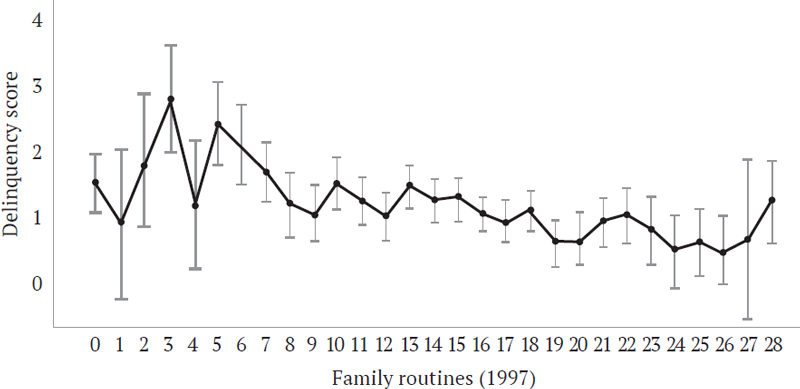
The Effect of Family Routines (1997) on DelinquencyCovariates in the model: gender = 1.48, ethnicity = 3.04, year of birth = 1983.02,age of biological mother at first birth = 23.23,gross household income in past year = 50484.10,biological mother’s highest grade = 12.89,biological father’s highest grade = 12.80.* Delinquency scores range from 0 to 10; higher scores specify more episodes of delinquency.** Family routine scores range from 0 to 28; higher scores specify more days spent in family routines.
Univariate testing found a significant difference among the 29 levels of family routines (scores range from 0 to 28; higher scores specify more days spent in family routines) on substance use (scores range from 0 to 3; higher scores specify more episodes of substance use), F (28, 2399) = 4.04, p < .001, η2p = .05. Levels 1 (M = 1.55), 3 (M = 1.89), 6 (M = 1.49), and 10 (M = 1.18) had significantly higher substance use relative to levels 16 (M = .70) through 28 (M = .62).
As shown in figure 2, higher levels of family routines were linked to a lower probability for substance use.
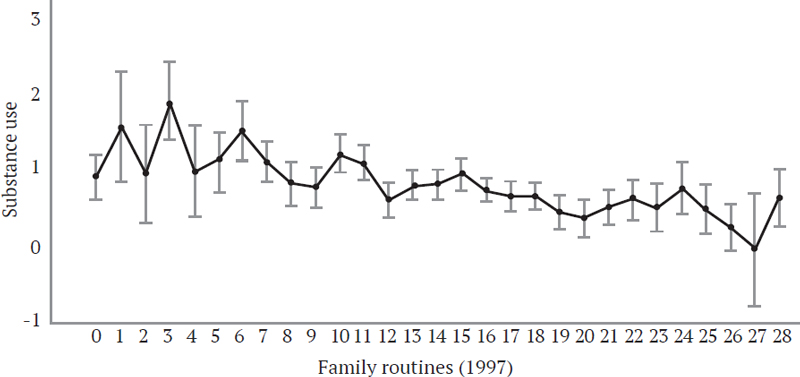
The Effect of Family Routines (1997) on Substance UseCovariates in the model: gender = 1.48, ethnicity = 3.04, year of birth = 1983.02,age of biological mother at first birth = 23.23,gross household income in past year = 50484.10,biological mother’s highest grade = 12.89,biological father’s highest grade = 12.80.* Substance use scores range from 0 to 3; higher scores specify more episodes of substance use.** Family routine scores range from 0 to 28; higher scores specify more days spent in family routines.
B. Family Routines (1998) on Delinquency and Substance Use
A statistically significant multivariate test was observed from family routines, Pillai’s Trace = .048, F (42, 4798) = 2.80, p < .001, η2p = .02.
Univariate testing found a significant difference among the 22 levels of family routines (scores range from 0 to 21; higher scores specify more days spent in family routines) on delinquency (scores range from 0 to 10; higher scores specify more episodes of delinquency), F (21, 2399) = 3.05, p < .001, η2p = .03. Levels 1 (M = 2.03) and 2 (M = 1.77) had significantly higher delinquency compared to levels 9 (M = 1.25) through 21 (M = .87) (there was no significant difference between levels 2 and 18).
As shown in figure 3, higher levels of family routines were linked to a lower probability for delinquency.
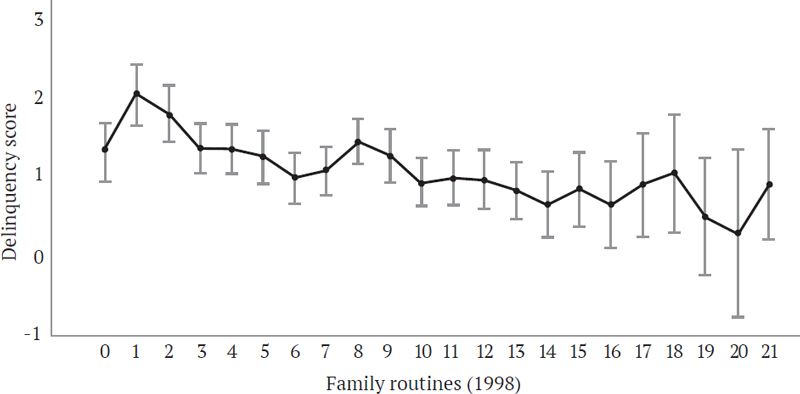
The Effect of Family Routines (1998) on Delinquency.Covariates in the model: gender = 1.48, ethnicity = 3.04, year of birth = 1983.02,age of biological mother at first birth = 23.23,gross household income in past year = 50484.10,biological mother’s highest grade = 12.89,biological father’s highest grade = 12.80.* Delinquency scores range from 0 to 10; higher scores specify more episodes of delinquency.** Family routine scores range from 0 to 21; higher scores specify more days spent in family routines.
Univariate testing found a significant difference among the 22 levels of family routines (scores range from 0 to 21; higher scores specify more days spent in family routines) on substance use (scores range from 0 to 3; higher scores specify more episodes of substance use), F (21, 2399) = 4.15, p < .001, η2p = .04. Levels 0 (M = 1.21), 1 (M = 1.23), 2 (M = 1.18), and 3 (M = 1.01) had significantly higher substance use relative to levels 9 (M = .65) through 21 (M = .58) (there was no significant difference between level 3 and levels 17 and 21).
As shown in figure 4, higher levels of family routines were linked to a lower probability for substance use.

The Effect of Family Routines (1998) on Substance UseCovariates in the model: gender = 1.48, ethnicity = 3.04, year of birth = 1983.02,age of biological mother at first birth = 23.23,gross household income in past year = 50484.10,biological mother’s highest grade = 12.89,biological father’s highest grade = 12.80.* Substance use scores range from 0 to 3; higher scores specify more episodes of substance use.** Family routine scores range from 0 to 21; higher scores specify more days spent in family routines.
C. Family Routines (1999) on Delinquency and Substance Use
A statistically significant multivariate test was observed from family routines, Pillai’s Trace = .051, F (42, 4362) = 2.72, p < .001, η2p = .03.
Univariate testing found a significant difference among the 22 levels of family routines (scores range from 0 to 21; higher scores specify more days spent in family routines) on delinquency (scores range from 0 to 10; higher scores specify more episodes of delinquency), F (21, 2173) = 1.91, p = .008, η2p = .02. Levels 1 (M = 1.18) and 2 (M = 1.21) had significantly higher delinquency compared to levels 4 (M = .64) through 21 (M = .35) (there was no significant difference between level 18 and levels 1 and 2).
As shown in figure 5, higher levels of family routines were linked to a lower probability for delinquency.
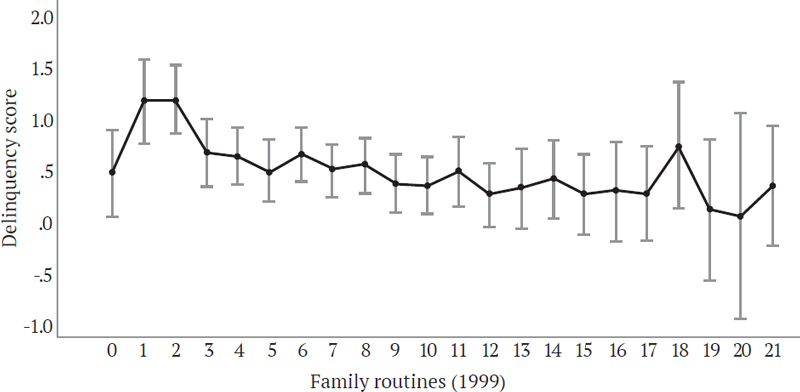
The Effect of Family Routines (1999) on DelinquencyCovariates in the model: gender = 1.48, ethnicity = 3.02, year of birth = 1983.09,age of biological mother at first birth = 23.30,gross household income in past year = 50424.16,biological mothers highest grade = 12.88,biological fathers highest grade = 12.77.* Delinquency scores range from 0 to 10; higher scores specify more episodes of delinquency.** Family routine scores range from 0 to 21; higher scores specify more days spent in family routines.
Univariate testing found a significant difference among the 22 levels of family routines (scores range from 0 to 21; higher scores specify more days spent in family routines) on substance use (scores range from 0 to 3; higher scores specify more episodes of substance use), F (21, 2173) = 4.40, p < .001, η2p = .04. Levels 0 (M = 1.17) through 4 (M = 1.46) had significantly higher substance use relative to levels 12 (M = .55) through 21 (M = .43) (there was no significant difference between levels 0 and 18).
As shown in figure 6, higher levels of family routines were linked to a lower probability for substance use.
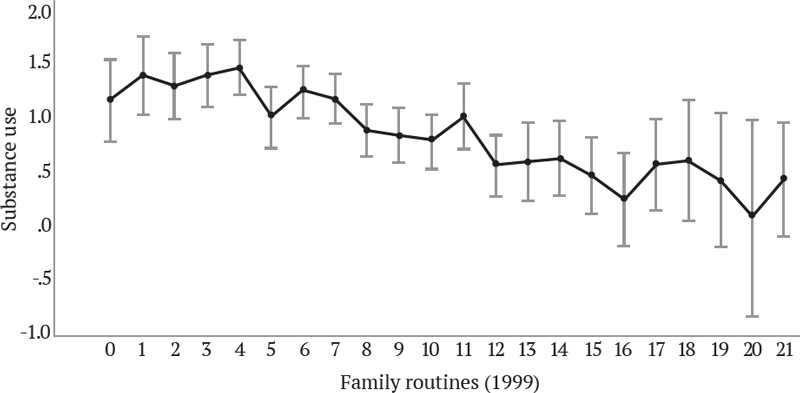
The Effect of Family Routines (1999) on Substance UseCovariates in the model: gender = 1.48, ethnicity = 3.02, year of birth = 1983.09,age of biological mother at first birth = 23.30,gross household income in past year = 50424.16,biological mother’s highest grade = 12.88,biological father’s highest grade = 12.77.* Substance use scores range from 0 to 3; higher scores specify more episodes of substance use.** Family routine scores range from 0 to 21; higher scores specify more days spent in family routines.
D. Family Routines (2000) on Delinquency and Substance Use
A statistically significant multivariate test was observed from family routines, Pillai’s Trace = .036, F (42, 4346) = 1.89, p < .001, η2p = .02.
Univariate testing indicated that there was not a significant difference among the 22 levels of family routines on delinquency, F (21, 2173) = 1.52, p = .061, η2p = .01.
Univariate testing found a significant difference among the 22 levels of family routines (scores range from 0 to 21; higher scores specify more days spent in family routines) on substance use (scores range from 0 to 3; higher scores specify more episodes of substance use), F (21, 2173) = 2.69, p < .001, η2p = .03. Levels 0 (M = 1.40), 2 (M = 1.38), and 3 (M = 1.31) had significantly higher substance use relative to levels 06 (M = .84) through 21 (M = .56) (there was no significant difference between level 20 and levels 0, 2, and 3).
As shown in figure 7, higher levels of family routines were linked to a lower probability for substance use.
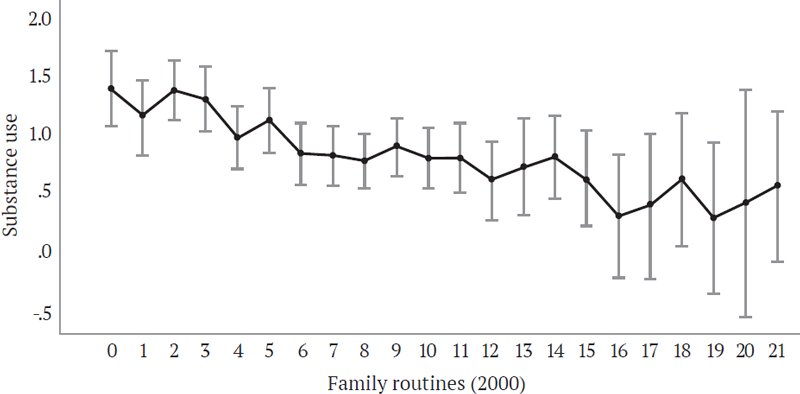
The Effect of Family Routines (2000) on Substance UseCovariates in the model: gender = 1.48, ethnicity = 3.02, year of birth = 1983.09,age of biological mother at first birth = 23.30,gross household income in past year = 50424.16,biological mother’s highest grade = 12.88,biological father’s highest grade = 12.77.* Substance use scores range from 0 to 3; higher scores specify more episodes of substance use.** Family routine scores range from 0 to 21; higher scores specify more days spent in family routines.
V. Results for the Second Test (NLSY79CYA)
A. How Often the Mother Reads to the Child Years 3-5 (1988) on Antisocial Behavior and Child Bullies or Is Cruel/Mean to Others
A statistically significant multivariate test was observed from mother-child reading yrs 3-5 (1988), Pillai’s Trace = .030, F (10, 2156) = 3.23, p < .001, η2p = .02.
Univariate testing found a significant difference among the 6 levels of mother-child reading (scores range from 1 to 6; higher scores indicate more days spent reading) on antisocial behavior (scores range from 0 to 6; higher scores indicate greater incidents of antisocial behavior), F (5, 1078) = 6.14, p < .001, η2p = .03. A post hoc analysis using Fisher’s LSD test specified significant differences between two main groups of mother-child reading, wherein levels 5 (M = 1.30) and 6 (M = 1.15) had significantly lower antisocial behavior compared to levels 1 (M = 1.94) through 3 (M = 1.62). Level 6 also had significantly lower antisocial behavior compared to level 4 (M = 1.50).
As shown in figure 8, higher levels of mother-child reading years 3-5 (1988) were linked to a lower probability for antisocial behavior.
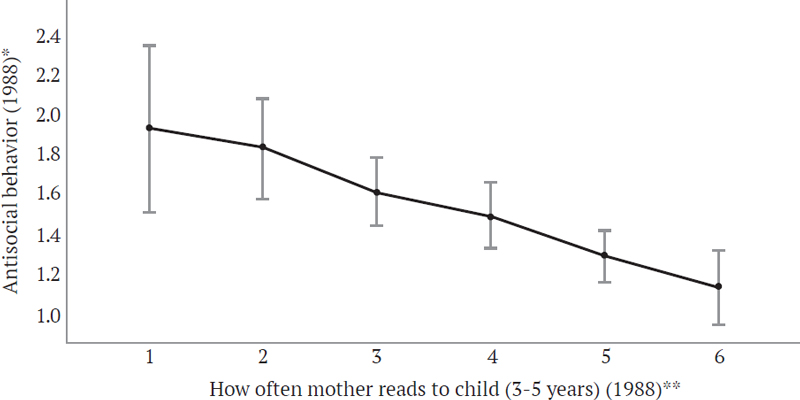
The Effect of Mother-Child Reading Years 3-5 (1988) on Antisocial BehaviorCovariates in the model: Gender = 1.52, Ethnicity = 2.34, Date of Birth = 1983.16* Scores range from 0 to 6; higher scores indicate greater incidents of antisocial behavior.** Scores range from 1 to 6; higher scores indicate more days spent reading.
Univariate testing indicated that there was not a significant difference among the 6 levels of mother-child reading, F (5, 1078) = 2.04, p = .07, η2p = .01.
B. How Often the Mother Reads to the Child Years 6-9 (1988) on Antisocial Behavior and Child Bullies or is Cruel/Mean to Others
A statistically significant multivariate test was observed from mother-child reading yrs 6-9 (1988), Pillai’s Trace = .021, F (10, 3570) = 3.81, p < .001, η2p = .01.
Univariate testing found a significant difference among the 6 levels of mother-child reading (scores range from 1 to 6; higher scores indicate more days spent reading) on antisocial behavior (scores range from 0 to 6; higher scores indicate greater incidents of antisocial behavior), F (5, 1785) = 7.08, p < .001, η2p = .02. Levels 5 (M = 1.47) and 6 (M = 1.41) had significantly lower antisocial behavior compared to levels 1 (M = 1.88), 2 (M = 2.09), and 4 (M = 1.74).
As shown in figure 9, higher levels of mother-child reading years 6-9 (1988) were linked to a lower probability for antisocial behavior.
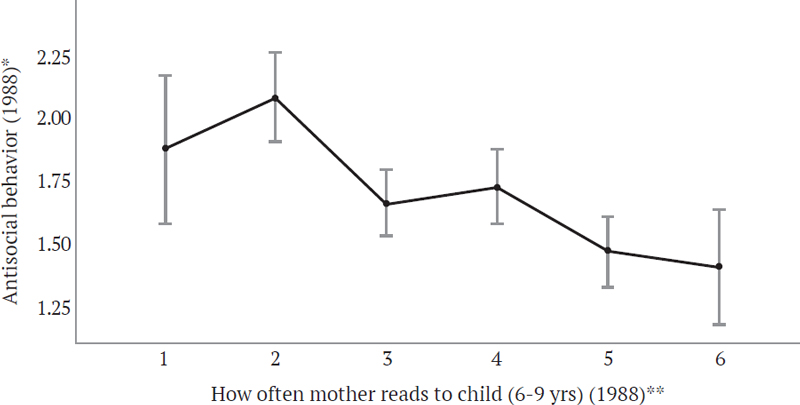
The Effect of Mother-Child Reading Years 6-9 (1988) on Antisocial BehaviorCovariates in the model: Gender = 1.48, Ethnicity = 2.29, Date of Birth = 1980.39.* Scores range from 0 to 6; higher scores indicate greater incidents of antisocial behavior.** Scores range from 1 to 6; higher scores indicate more days spent reading.
Univariate testing found a significant difference among the 6 levels of mother-child reading (scores range from 1 to 6; higher scores indicate more days spent reading) on bullying or being cruel/mean (scores range from 1 to 3; lower scores indicate greater incidents of bullying or being cruel/mean), F (5, 1785) = 2.36, p = .038, η2p = .01. Level 2 (M = 2.59) had significantly more bullying or being cruel/mean compared to levels 3 (M = 2.69) through 6 (M = 2.72).
As shown in figure 10, higher levels of mother-child reading years 6-9 (1988) were linked to a lower probability for bullying or being cruel/mean to others.
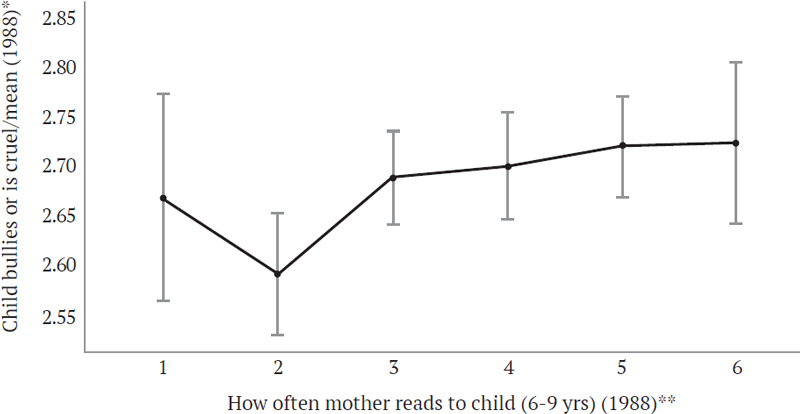
The Effect of Mother-Child Reading Years 6-9 (1988) on Bullying or Being Cruel/Mean to OthersCovariates in the model: Gender = 1.48, Ethnicity = 2.29, Date of Birth = 1980.39.* Scores range from 1 to 3; lower scores indicate greater incidents of bullying or being cruel/mean.** Scores range from 1 to 6; higher scores indicate more days spent reading.
C. How Often the Mother Reads to the Child Years 3-5 (1998) on Antisocial Behavior and Child Bullies or Is Cruel/Mean to Others
A statistically significant multivariate test was obtained from mother-child reading yrs 3-5 (1998), Pillai’s Trace = .065, F (10, 1120) = 3.73, p < .001, η2p = .03. However, univariate tests found either inconclusive results (antisocial behavior) or no significant differences among the levels (child bullies or is cruel/mean to others). Ultimately, this test was unsupportive of the hypotheses.
D. How Often the Mother Reads to the Child Years 6-9 (1998) on Antisocial Behavior and Child Bullies or Is Cruel/Mean to Others
A statistically significant multivariate test was observed from mother-child reading yrs 6-9 (1998), Pillai’s Trace = .030, F (10, 2770) = 4.23, p < .001, η2p = .02.
Univariate testing found a significant difference among the 6 levels of mother-child reading (scores range from 1 to 6; higher scores indicate more days spent reading) on antisocial behavior (scores range from 0 to 6; higher scores indicate greater incidents of antisocial behavior), F (5, 1385) = 8.07, p < .001, η2p = .03. Levels 5 (M = 1.17) and 6 (M = .98) had significantly lower antisocial behavior compared to levels 1 (M = 2.20) through 4 (M = 1.40).
As shown in figure 11, higher levels of mother-child reading years 6-9 (1998) were linked to a lower probability for antisocial behavior.
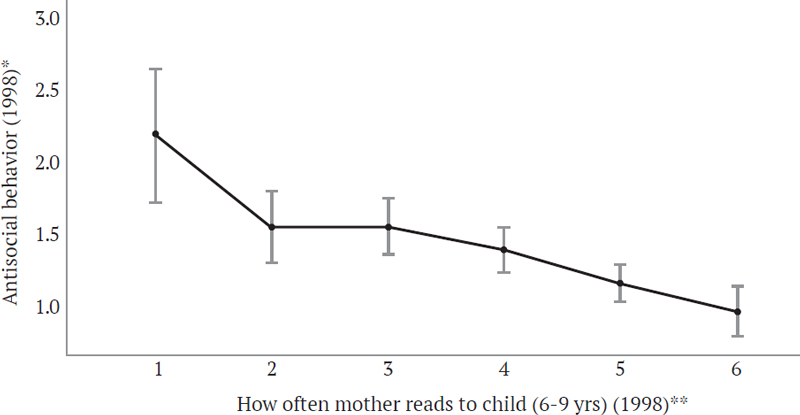
The Effect of Mother-Child Reading Years 6-9 (1998) on Antisocial BehaviorCovariates in the model: Gender = 1.49, Ethnicity = 2.34, Date of birth = 1989.87.* Scores range from 0 to 6; higher scores indicate greater incidents of antisocial behavior.** Scores range from 1 to 6; higher scores indicate more days spent reading.
Univariate testing found a significant difference among the 6 levels of mother-child reading (scores range from 1 to 6; higher scores indicate more days spent reading) on bullying or being cruel/mean (scores range from 1 to 3; lower scores indicate greater incidents of bullying or being cruel/mean), F (5, 1385) = 3.87, p = .002, η2p = .01. Levels 1 (M = 2.61) and 3 (M = 2.73) had significantly more bullying or being cruel/mean compared to levels 5 (M = 2.82) and 6 (M = 2.86). Level 4 (M = 2.77) had significantly more bullying or being cruel/mean compared to level 6.
As shown in figure 12, higher levels of mother-child reading years 6-9 (1998) were linked to a lower probability for bullying or being cruel/mean to others.
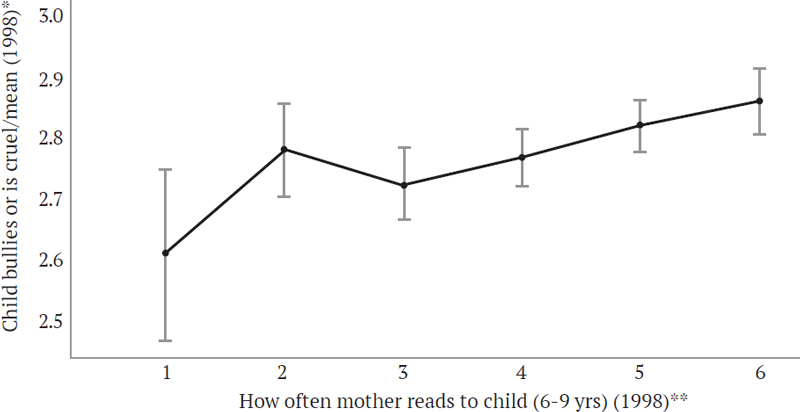
The Effect of Mother-Child Reading Years 6-9 (1998) on Bullying or Being Cruel/Mean to OthersCovariates in the model: Gender = 1.49, Ethnicity = 2.34, Date of birth = 1989.87.* Scores range from 1 to 3; lower scores indicate greater incidents of bullying or being cruel/mean.** Scores range from 1 to 6; higher scores indicate more days spent reading.
VI. Conclusions and Further Study
The results show that increased levels of family routines, a form of Confucian ritual, were linked to reduced delinquency and substance use. High levels of mother-child reading, a form of Confucian ritual, were linked to reduced antisocial behavior and bullying or being cruel/mean to others. These findings indicate that Confucian ritual is closely linked to reduced deviancy and have implications for behavior control (namely, delinquent and criminal rehabilitation, the prevention of deviancy, and substance abuse programs).
Nationally representative samples were used that provided a wide range of material concerning rituals, family routines, antisocial behavior, delinquency, substance use, and other aspects of the family, allowing for the documentation of factors impacting deviancy. The NLSY97 and NLSY79CYA are high-level datasets that are commonly employed in descriptive research.8
The multifaceted nature of the ritual-deviancy relationship is worth mention. Family routines may be statistically associated with reduced deviancy in ways that are not understood in the current analysis. It is possible that similar underlying influences, such as socioeconomic conditions, education, household income, etc., may be influencing the connection found in this study.
Future studies might investigate the form of ritual exhibited to determine which rituals are most likely to modify undesirable behavioral outcomes. For example, parent-child bedtime routines9 and family dinner routines10 have been linked with encouraging cognitive/behavioral results for children. An analysis of specific rituals and their capacity to impact adverse behavioral outcomes would be helpful.
Future studies might also test crime data assembled from Confucian cultures to test Confucian thought. Data on Confucian rituals gathered in, for instance, China or South Korea may help confirm these findings. However, the data being from the United States does not moderate the results. Meaningful results employing American data intensifies the robustness of the outcomes, in that the link between Confucianism and reduced deviancy is so robust that it is recognized in data from the United States. It is the quality of the variables that counts: the variables were a form of Confucian ritual, and they were associated with reduced deviancy. Whether the participants were Chinese or American was of little consequence in the final evaluation of this study.
The significant findings show that Confucian ritual is meaningfully linked with reduced deviancy among young people. Reducing deviancy through ritual will increase public safety. This study shows the advantages of Confucian ritual, particularly in the sphere of criminology, which enlarges the focus of previous researches.
References
- Bell, Daniel A. 2008. China’s New Confucianism: Politics and Everyday Life in a Changing Society. Princeton: Princeton University Press.
- Book of Rites. In Chinese Text Project, edited by Donald Sturgeon. https://ctext.org
- Bureau of Labor Statistics, U.S. Department of Labor. 2019. National Longitudinal Survey of Youth 1997 Cohort, 1997-2017 (rounds 1-18). Produced and Distributed by the Center for Human Resource Research (CHRR), Ohio State University. Columbus, OH.
- Bureau of Labor Statistics, U.S. Department of Labor. 2019. National Longitudinal Survey of Youth 1979 Child and Young Adults Cohort, 1979-2018. Produced and Distributed by the Center for Human Resource Research (CHRR), Ohio State University. Columbus, OH.
-
Cline, Erin M. 2015. Families of Virtue: Confucian and Western Views on Childhood Development. Columbia University Press.
[https://doi.org/10.7312/columbia/9780231171557.001.0001]

- Cline, Erin M. 2020. Little Sprouts and the Dao of Parenting: Ancient Chinese Philosophy and the Art of Raising Mindful, Resilient, and Compassionate Kids. New York: W. W. Norton.
-
Cramer, Elliot M., and R. Darrell Bock. 1966. “Multivariate Analysis.” Review of Educational Research 36: 604-17.
[https://doi.org/10.3102/00346543036005604]

-
Elgar, Frank J., Wendy Craig, and Stephen J. Trites. 2013. “Family Dinners, Communication, and Mental Health in Canadian Adolescents.” Journal of Adolescent Health 52 (4): 433-38.
[https://doi.org/10.1016/j.jadohealth.2012.07.012]

-
Elgar, Frank J., et al. 2014. “Cyberbullying Victimization and Mental Health in Adolescents and the Moderating Role of Family Dinners.” JAMA Pediatrics 168 (11): 1015-22.
[https://doi.org/10.1001/jamapediatrics.2014.1223]

-
Farrington, David. P. 2005. “Childhood Origins of Antisocial Behavior.” Clinical Psychology and Psychotherapy 12 (3): 177-90.
[https://doi.org/10.1002/cpp.448]

-
Ferretti, Larissa K., and Kristen L. Bub. 2017. “Family Routines and School Readiness During the Transition to Kindergarten.” Early Education and Development 28 (1): 59-77.
[https://doi.org/10.1080/10409289.2016.1195671]

-
Fiese, Barbara H., and Christine A. Kline. 1993. “Development of the Family Ritual Questionnaire: Initial Reliability and Validation Studies.” Journal of Family Psychology 6 (3): 290-99.
[https://doi.org/10.1037/0893-3200.6.3.290]

-
Fiese, Barbara H., Kimberly P. Koley, and Mary Spagnola. 2006. “Routine and Ritual Elements in Family Mealtimes: Contexts for Child Well-Being and Family Identity.” New Directions for Child and Adolescent Development 111: 67-89.
[https://doi.org/10.1002/cd.156]

-
Guidubaldi, John, et al. 1986. “The Role of Selected Family Environment Factors in Children’s Post-Divorce Adjustment.” Family Relations 35 (1): 141-51.
[https://doi.org/10.2307/584293]

- Guidubaldi, John, Joseph D. Perry, and Bonnie K. Nastasi. 1987. “Growing Up in a Divorced Family: Initial and Long-Term Perspectives on Children’s Adjustment.” In Family Processes and Problems: Social Psychological Aspects, edited by Stuart Oskamp, 202–37. Newbury Park, CA: Sage.
-
Hoffmann, John P., and Elizabeth Warnick. 2013. “Do Family Dinners Reduce the Risk for Early Adolescent Substance Use? A Propensity Score Analysis.” Journal of Health and Social Behavior 54 (3): 335-52.
[https://doi.org/10.1177/0022146513497035]

-
Hutton, Eric L. 2021. “On Ritual and Legislation.” European Journal for Philosophy of Religion 13 (2): 45-64.
[https://doi.org/10.24204/ejpr.2021.3333]

- Ivanhoe, Philip J. 2000. Confucian Moral Self Cultivation. 2nd ed. Indianapolis/Cambridge: Hackett Publishing.
-
Ivanhoe, Philip J. 2013. Confucian Reflections: Ancient Wisdom for Modern Times. Routledge.
[https://doi.org/10.4324/9780203749432]

-
Kiser, Laurel J., et al. 2005. “Family Ritual and Routine: Comparison of Clinical and Non-Clinical Families.” Journal of Child and Family Studies 14: 357-72.
[https://doi.org/10.1007/s10826-005-6848-0]

-
Kitsaras, George, et al. 2018. “Bedtime Routines Child Wellbeing and Development.” BMC Public Health 18 (1): 386.
[https://doi.org/10.1186/s12889-018-5290-3]

- Legge, James. 2016. The Book of Rites. The Bilingual Reading of the Chinese Classic. Zhengzhou: Zhongzhou guji.
-
Malaquias, Sara, Crespo Crespo, and Rita Francisco. 2015. “How Do Adolescents Benefit from Family Rituals? Links to Social Connectedness, Depression, and Anxiety.” Journal of Child and Family Studies 24: 3009-17.
[https://doi.org/10.1007/s10826-014-0104-4]

-
Mindell, Jodi A., and Ariel A. Williamson. 2018. “Benefits of a Bedtime Routine in Young Children: Sleep Development, and Beyond.” Sleep Medicine Reviews 40: 93-108.
[https://doi.org/10.1016/j.smrv.2017.10.007]

-
Puett, Michael. 2015. “Ritual and Ritual Obligations: Perspectives on Normativity from Classical China.” Journal of Value Inquiry 49 (4): 543-50.
[https://doi.org/10.1007/s10790-015-9524-7]

-
Santos, Susana, et al. 2012. “Quality of Life and Adjustment in Youths with Asthma: The Contributions of Family Rituals and the Family Environment.” Family Process 51 (4): 557-69.
[https://doi.org/10.1111/j.1545-5300.2012.01416.x]

-
Sen, Bisakha. 2010. “The Relationship Between Frequency of Family Dinner and Adolescent Problem Behaviors after Adjusting for Other Family Characteristics.” Journal of Adolescence 33 (1): 187-96.
[https://doi.org/10.1016/j.adolescence.2009.03.011]

- Wang, Tangjia. 2012. “Ritual: Meaning and Recognition.” In Ritual and the Moral Life, edited by David Solomon, Ping-Cheung Lo, and Ruiping Fan, 89-104. Dordrecht, Netherlands: Springer.
- Xunzi. 1999. Xunzi, translated by John Knoblock. Changsha: Hunan People’s Publishing House.
- Xunzi. 2003. Basic Writings, translated by Burton Watson. New York: Columbia University Press.
